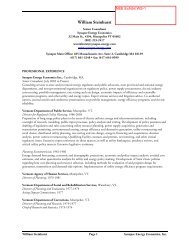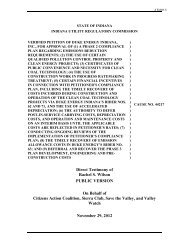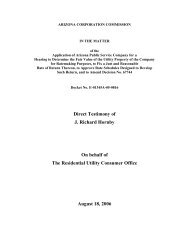Best Practices in Energy Efficiency Program Screening - Synapse ...
Best Practices in Energy Efficiency Program Screening - Synapse ...
Best Practices in Energy Efficiency Program Screening - Synapse ...
You also want an ePaper? Increase the reach of your titles
YUMPU automatically turns print PDFs into web optimized ePapers that Google loves.
eferred to as the market price suppression effect. (<strong>Synapse</strong> 2011, pp. 1-17-18, 2-49-<br />
50, 6-30-37.)<br />
The market price suppression effect is expected to primarily occur over the short-term<br />
period after the energy efficiency measure is implemented. Over the long-term, when<br />
new physical capacity is needed to ma<strong>in</strong>ta<strong>in</strong> the reliability of the system, the capacity<br />
price is likely to be set by the long-run marg<strong>in</strong>al cost of new capacity and will hence be<br />
less sensitive to reductions <strong>in</strong> demand. Even then, capacity prices could be lower with<br />
energy efficiency than without because the long-run capacity supply curve is likely to<br />
have a lower slope. One of the challenges <strong>in</strong> estimat<strong>in</strong>g the impact of energy efficiency<br />
on market prices is dist<strong>in</strong>guish<strong>in</strong>g between the short- and long-term market price impacts<br />
(<strong>Synapse</strong> 2011, pp. 1-17-18, 2-49-50, 6-30-37).<br />
In determ<strong>in</strong><strong>in</strong>g the price suppression effect <strong>in</strong> New England, the AESC Study followed a<br />
two-step approach. The first step is to estimate the impact a reduction <strong>in</strong> load will have<br />
upon the market price, assum<strong>in</strong>g no other changes occur. The second step is to<br />
estimate the pace at which suppliers participat<strong>in</strong>g <strong>in</strong> that market will respond to that<br />
reduction with actions that offset the reduction and eventually cause the market price to<br />
move toward the level it would have been under the Reference Case. In other words,<br />
responses taken by market participants will eventually offset, or dissipate, the price<br />
suppression impact.<br />
Figures A.3 and A.4 summarize both the annual energy and capacity price suppression<br />
effects <strong>in</strong> New England from the AESC Study. The AESC Study projects an 11 year<br />
phase-out for energy-related price suppression effects and a 12 year phase-out for<br />
capacity-related price suppression effects (<strong>Synapse</strong> 2011, p.6-2). This phase out is<br />
depicted <strong>in</strong> Figures A.3 and A.4 by the tail at zero that beg<strong>in</strong>s <strong>in</strong> 2025 for energy price<br />
suppression and 2027 for capacity price suppression. The longer projected dissipation<br />
of the capacity price suppression effect is based upon a detailed analysis of the various<br />
factors that tend to offset the reduction <strong>in</strong> capacity prices. Those factors <strong>in</strong>clude: (1)<br />
tim<strong>in</strong>g of new capacity additions, (2) tim<strong>in</strong>g of retirements of exist<strong>in</strong>g capacity, (3)<br />
elasticity of customer demand, and (4) the portion of capacity that LSEs acquire from the<br />
FCM. (<strong>Synapse</strong> 2011, p.6-2). Also note that the impact on capacity prices is not<br />
experienced until 2016; three years after efficiency measures have been <strong>in</strong>stalled.<br />
Figure A.3. <strong>Energy</strong> Price Suppression<br />
| 72 <strong>Best</strong> <strong>Practices</strong> <strong>in</strong> <strong>Energy</strong> <strong>Efficiency</strong> <strong>Program</strong> Screen<strong>in</strong>g | www.nhpci.org







